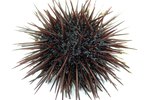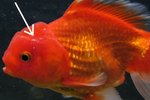
Camallanus are tiny roundworms known to infect a wide variety of freshwater fish. They appear as thin, red threads emerging from a fish's anal vent. You may see expelled worms floating in your aquarium. Many camallanus worm species commonly infect both wild and aquarium fish. Fish become hosts of the parasite when they ingest infected crustaceans.
They Feed on Blood
Camallanus worms vary in size, depending on their age and species; larger parasites may reach up to 2 millimeters long. Their long, slim bodies are smooth, with no hooks or legs. Roundworms are cylindrical, rather than flat like tapeworms. Mature worms obtain their red coloration by feasting on the host fish's blood. Camallanus worms can tunnel through body tissue, causing internal and external damage.
Some are Picky
Most camallanus species affect a wide variety of fish, while others are only found in certain fish types. The species most commonly seen in freshwater aquariums is Camallanus cotti, native to eastern Asia. They infect many fish types, including live-bearers and egg-layers, catfish, cichlids, rainbows and more. Camallanus lactustris, from Europe and western Asia, and south Asia's Camallanus anabantis may also appear in aquariums and ponds.
They Can be Difficult to Detect
Light camallanus infestations are tough to notice. The tell-tale red worms may not be visible, but juvenile fish will commonly experience slower growth rates and adults may experience difficulty reproducing. Bloating, external lumps and cysts, losing interest in food, weight loss and dying skin tissue can be indications of advanced parasitic infestation. Camallanus worms cause internal bleeding, irritated digestive tracts and bacterial infections as they eat their way through the fish.
They Rely on Intermediate Hosts
After breeding, the female camallanus gives birth to independent larvae. The larvae exit the fish in excreted feces. They molt twice in about a week, then remain inactive until small crustaceans, including cyclops and gammarus, ingest the contaminated feces. The larvae becomes active again, growing and molting in the crustacean's intestines. When the crustacean is eaten by a fish, the larvae undergoes its final two molts, becoming an adult worm. Species type and water temperature affect the life-cycle time span.
Medicate Your Aquarium
Consult a veterinarian or aquaculture expert for proper diagnoses, which may include a fecal examination, a biopsy or a necropsy. Medical treatments are available to rid your aquarium of camallanus parasites. Most treatments require three weekly applications, and cleaning or replacing the substrate 24 hours after each application. These medicines may be toxic to shrimp and snails. Some treatments paralyze, rather than kill, the parasites. Pink or white paralyzed worms are excreted from the fish's vent.
References
Photo Credits
-
Jerry Yulsman/Photodisc/Getty Images
Writer Bio
Karen Mihaylo has been a writer since 2009. She has been a professional dog groomer since 1982 and is certified in canine massage therapy. Mihaylo holds an associate degree in human services from Delaware Technical and Community College.




